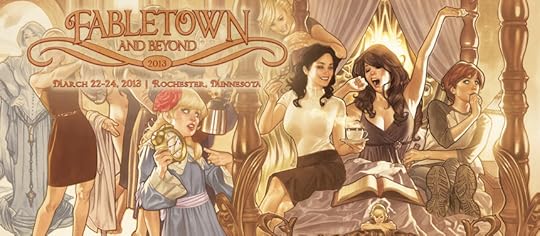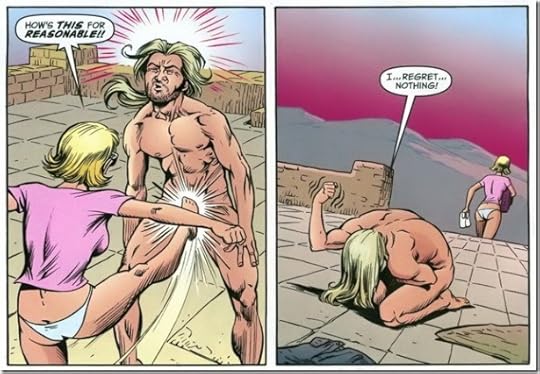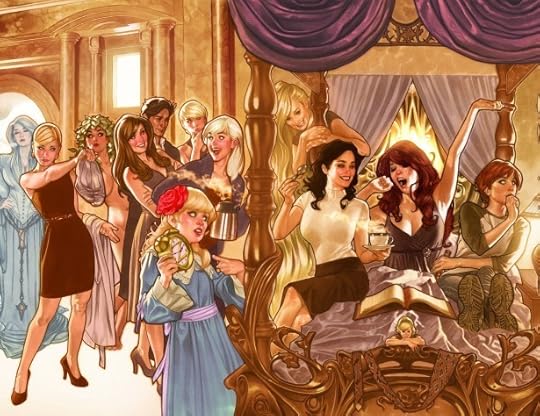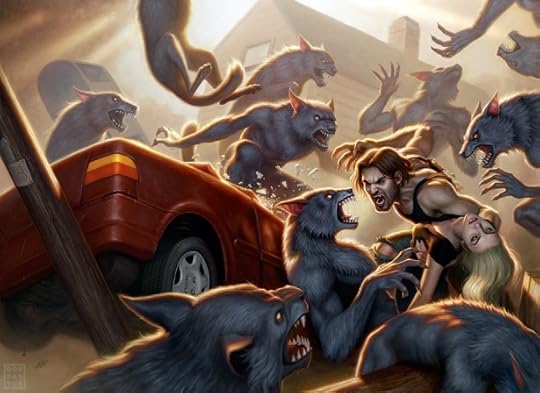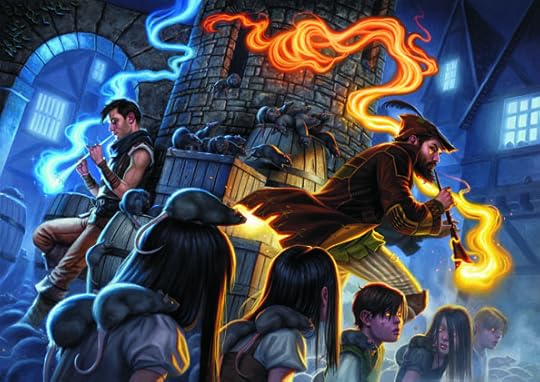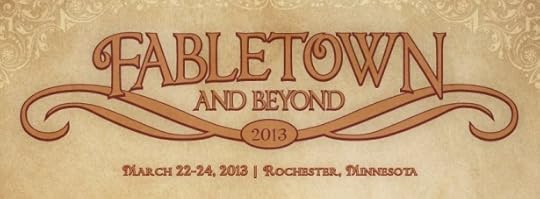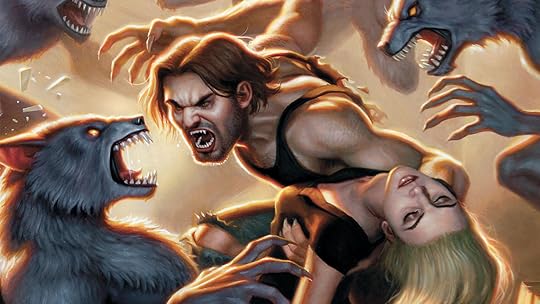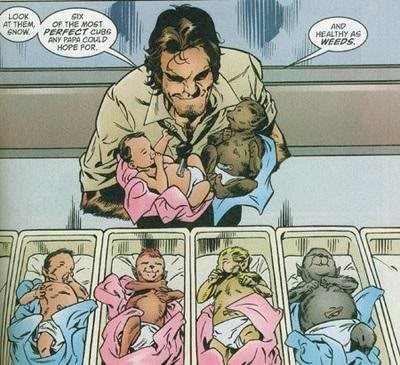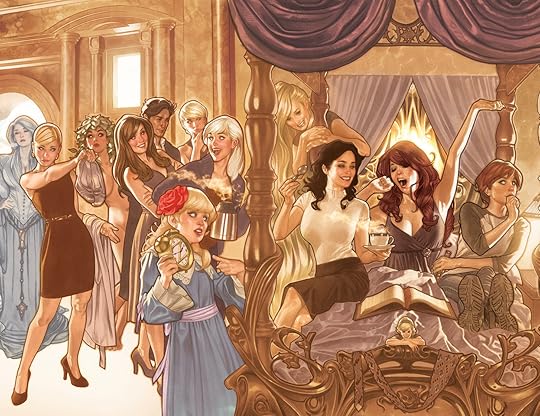Bill Willingham's Blog, page 8
February 7, 2013
Tucson Festival Of Books Cancellation
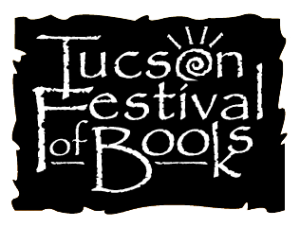 Bill was originally planning on attending the Tucson Festival Of Books on March 9 and 10, but unfortunately a personal matter has come up and Bill will no longer be able to be a part of the show.
Bill was originally planning on attending the Tucson Festival Of Books on March 9 and 10, but unfortunately a personal matter has come up and Bill will no longer be able to be a part of the show.
We apologize to the fans who were planning on attending to see Bill, but his being at the show is just not feasible at this time. His other appearances this year are posted on the Appearances page and hopefully he’ll be able to make it to Tucson sometime in the future.
January 29, 2013
ComicBookMovie.com: Interview With FABLES’ Creator Bill Willingham Part. 2
By Mark Julian – 1/29/2013

Mark Julian: The next story arc in Fables focuses on Snow White. What can fans look forward to reading in these next few issues?
Bill Willingham: Snow White is going to go through a few bad days. If I recall correctly, I think the entire arc takes place over just a few days. It’s pretty truncated in the sense of the amount of time that passes. It happens when Snow White, as seen in the Cubs in Toyland arc, is missing a couple of her children. This takes place before that final scene in Cubs in Toyland and wraps up some of it. She’s just sent Bigby off to go looking for the missing cubs, while she stays home with the remaining ones just in case they are trying to reach home. That should be as much tragedy as any parent should have to go through at any given time but on top of all this, some other really, really bad thing happens and we get to see what Snow White is made of. The thing I oft tell is it’s no happy thing for someone in Fables to get a story arc named after them because that means they’re about to go through as many fun ‘crisises’ as we can dream up and we’ve dreamed up a few good ones for her.
MJ: You’ve been writing Fables for a little over 10 years now. Do you know how the story ends or maybe it doesn’t with it being fairy tales and folklore?
BW: To a certain extent, the fairy tales and folklore don’t end. Our versions of these characters aren’t public domain but the characters that they’re based on are so there’s going to be lots of more stories about these characters long after I’m gone. How it ends? My perfect ending for all of Fables would be my finally wrapping of the series, writing the very last line, the very last story, realizing that I finally after how many ever years it is, tied up every dangling plot thread; I write the end to the very last script, send it off to Shelly Bond (Executive Editor at Vertigo) and then have that massive coronary right there and die at my table. That would be perfect. The main worry I have about the general mortality of us all is that I won’t get my word done. I want to get stuff done. As far as the storyline of how it ends, I have a few notions here and there, we’ll see.
MJ: Last question. Would you like to see Fables as a television show or movie?
BW: I could see advantages and disadvantages of each I suppose. Ultimately, Fables works best as what it is. But given that we are going to continue making Fables in comic book form and no matter what else we do, computer games, video games, novels, films, or tv series, the official version is going to be the comic book. Understanding that, I’d like to see all that stuff because it’s other ways to take a look at these wonderful characters and every different medium has its own strengths and I’d like to explore all of them.
You can purchase Fables: Werewolves of the Heartland by clicking HERE and Fairest,Vol 1 by clicking HERE. Or better yet, you can go purchase both from your Local Comic Shop. Follow Bill on Twitter @BillWillingham.
Fables is a comic book series created by writer Bill Willingham, published by DC Comics’s Vertigo imprint beginning in 2002. The series deals with various characters from fairy tales and folklore – referring to themselves as “Fables” – who have been forced out of their Homelands by “The Adversary” who has conquered the realm. The Fables have traveled to our world and formed a clandestine community in New York City known as Fabletown. Fables who are unable to blend in with human society (such as monsters and anthropomorphic animals) live at “the Farm” in upstate New York.
When you think of fables and folklore you naturally think it’s kid’s stuff but Fables is anything but, the series imagines your favorite fairytale heroes and villains as real individuals. They smoke, drink, lie, steal, cheat, find love and lose it in manners dripping with real-world panache that at times will have you howling with laughter or sometimes shedding a tear or two.
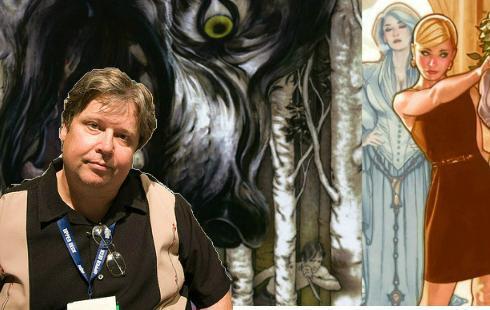 Originally posted on ComicBookMovie.com
Originally posted on ComicBookMovie.com
NEAR MINTerview w/ Bill Willingham

2013 is upon us and we’re kicking off the new year with one of our biggest guests to date. Bill Willingham is the Eisner Award-winning creator of Fables and he joined us for an in-depth conversation about the series and it’s ever-growing universe.
Willingham reveals his secret origin as an MP before breaking into comics as a penciler. Then, we discuss the latest Fables collection (vol. 18, “Cubs in Toyland”) and why you might need an english lit lesson before you read it. We also talk about the spinoff series, Fairest and the recent original graphic novel, Werewolves of the Heartland, and find out what character he couldn’t bear to turn over to another writer.
Later in the conversation we learn about Fabletown and Beyond, a 3-day convention coming to Minnesota, March 22-24 to celebrate Fables and other comics from the “mythic fiction” genre. Willingham gives his perspective on the departure of longtime Vertigo editor, Karen Berger and what it means for the future of the imprint. Finally, we wrap things up with a preview of the 2012 Minty Awards. What is Bill Willingham’s “Oh shit” Moment to the Year? Listen and find out.
Music in this episode by: Sara Bareilles
Originally posted on Near Mint Comic Show
January 24, 2013
ComicBookMovie.com: Interview With FABLES’ Bill Willingham Part 1
By Mark Julian – 1/24/2013

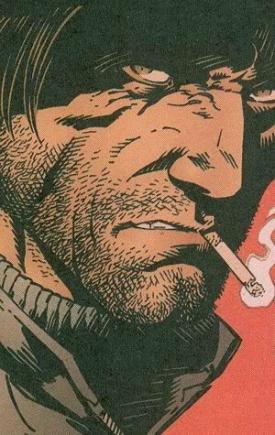 Mark Julian: Thematically, what are you looking to explore with Werewolves of the Heartland?
Mark Julian: Thematically, what are you looking to explore with Werewolves of the Heartland?
Bill Willingham:A couple of things. We always have our eye out for things that would make larger sidepieces. In all of Fables, I’ve never sat down and written a single story of this size. I’ve written arcs of Fables that turned out to be this size or larger in some cases but the act of doing that in a serial fashion sort of breaks up the pressure or the worry of ‘does this hold together as a single story’. I wanted to find something a little more challenging Fables-wise and we’ve been after a good venue in which to get Bigby off alone for some time and really show what this popular character is made of. In past Fables, we’ve hinted at and teased his violent, monstrous past but we’ve never really shown part of it, so that was one of the goals of this story, to have his monstrous nature get out a little bit. And then the questions being once he lets it out, can he get it safely bottled back up again. I think that’s one of the thematic questions for this story. All things considered, whenever we do Fables stories it’s ‘can we tell an interesting story that will keep the readers engaged, turning the pages and not feel cheated at the end’.
MJ: At what point did you come up with this story? It takes place during Fabletown’s confrontation with Mister Dark , so was Werewolves of the Heartland originally meant to be included in that arc or did you come up with the story later and this was just an ideal place to put it?
BW: It’s more of a case where that’s the ideal place to put it. Once we got Werewolves of the Heartland up and running, finding a place, with all the Fables plans in the future, where we could reasonably get Bigby off on his own was proving a little difficult. With some of the things that have happened and the things that are coming up, it was tough finding a spot. That particular point in Fables seemed a reasonable time to where if you’re going to look at another place for an alternate to Fabletown, that would be the good place to have it. So that worked out, it was serendipitous that the story worked out within the timeline at some point. That’s important for those for whom the timeline is significant. For most readers, not so much, it’s a self-contained story. As long as we know that yes, at some point Bigby can get out on his own, that’s what really counts.
MJ: As you said, Bigby is a fan favorite character for a lot of readers. Did that play a part in your decision to do a solo Bigby story- that is to say is this a reward for the fans? Or do you yourself have a special place in your heart for Bigby?
BW: I think both; I don’t think they’re exclusive motivations. Always, always, I hope to reward the fans for being fans with good stories. Bigby, he’s a protagonist of the old-school writ large. I think that lends itself to telling a good story. The other thing is of course I have an affection for the character and would like to get him out and make him the thing around which the story revolves rather than just someone who is also taking place, whose events are also part of the story. If you go back you’ll see that in very few instances is Bigby wolf one of the two main characters in Fables. It can be argued that he’s the driving force in possibly the first story where he has to solve a crime that didn’t actually get committed and maybe during the Mister Dark arc in the sense that it was very important that he accidentally convince his Dad to sacrifice himself to end this big, God-like evil thing coming after him. And I think that’s about it. So it was time for him to be the single mover or shaker that’s driving the plot. And in this case, it could only be this character since the plot was about a secret town of werewolves. If you have a secret town of werewolves anywhere and you also have a character that’s arguably the god of all wolves, you should probably find some way to get them together and see what happens.
MJ: Fairest, Vol. 1 was also just released and I know you wrote the first volume but going forward you’re turning that series over to other writers. What’s it like having other writers tell stories in the world you created?
BW: It’s both gratifying and fearsome. I likened it to the new parents that go through the tragedy of turning the kid over to the babysitter for the very first time. You know, ‘how much do you really know about this girl, is she going to look after your kid, does she know what to do if an emergency comes up?’ ‘How can our child be as important to her as it is to us’? All of those things do indeed go through my mind with the prospect of turning this story and these settings over to someone else. At the same time there’s a really nice payoff in that for the first time, I get to read Fables stories as a ‘reader’ and kind of wonder what’s happening next. Unfortunately, the way we work, I sort of have to know how the stories are resolved in order to do it but there is a lot of detail- like Lauren Beukes run on Rapunzel right now, which is in the monthly issues of Fairest, there’s a bunch that comes as a surprise to me and I get to read for the first time as a reader and that’s great, I love that part of it. Finding the balance between the two, that ‘careful, kind of concerned, looking over /looking after’ feeling watching these properties to make sure they don’t fall into evil hands is important but being surprised by good stories is equally important. The trick is I think, is finding good writers with good ideas and so far we’ve been quite successful at that.
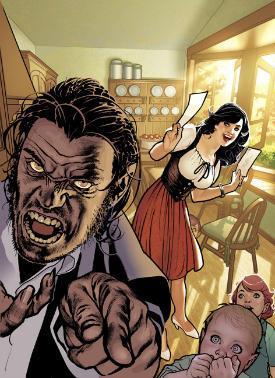 MJ: Let me put the shoe on the over foot, is there someone else’s creation that you would love to write for a story arc or two?
MJ: Let me put the shoe on the over foot, is there someone else’s creation that you would love to write for a story arc or two?
BW: Oh, constantly. The two warring things there is ‘this is wonderful, I wish I could do that’ and ‘don’t let me get in there and screw it up, keep it wonderful by keeping me out.’ I’m reading Saga from Brian K. Vaughn and Fionna Staples right now and there’s so much in there that I just wince at, it’s so well done. I look and say ‘agh I wish I could’ve done that or I wish I’d thought of that and how fun would that be.’ But I know if I did, it wouldn’t have that same quirky-oddness that they bring to it because it’s their quirky, odd creation. I’m going to just have to settle for the quirky-oddness that I can bring to my stuff. The one telling thing about any good story well told is that the readers get drawn into it enough to want to be part of it. I think that’s the case with any good story.
MJ: A more general question, is there any discernible difference between writing a Vertigo title and one for parent-company, DC?
BW: There’s quite a difference. For one thing, the stuff I did in the DCU with Superman, Batman, Justice Society, Robin and Shdaowpact and various other things are that they’re all DC’s characters. Ultimately, DC gets to decide what happens to them and what you can do and what you can’t do. I did blow up all of Chicago once without getting permission and that caused a little bit of chagrinry. It was allowed after some consultation but generally you can’t do anything you really think of with those characters. With Fables, the limiting factor is ‘what can I think of doing’ and ‘what do I want to do’ and that’s it which is nice. Although sometimes it’s not nice in the sense that too much freedom is almost a constraint in itself in that if you can do anything then is any given story good enough?’ Which happens from time to time but mostly, with lots of 2×4′s to the head and hard drinking, I dampen down those thoughts and move ahead. Who knows what the perfect story is but we’ll do the best stories we can do. With DCU, you can’t do everything you want to because they’re not your characters, I mean I could kill a whole bunch of them and I doubt that they’d lift that stick. Not that I want to… that sounds terrible, all I want to do is kill (laughs)…but I did have plans to have some iconic characters that had been around for 50 years, odd bits of them married off to each other. Which I guess when it comes down to it is a shipper. And that’s what they really didn’t want to have happen, they can deal with dying because they kill their characters all the time and they know how to bring them back. Breaking up marriages, there’s only been one substantial marriage broken up in comics which is Spider-Man making the deal with the Devil to breakup his marriage and save his Aunt and readers hated that. So I don’t think we’re good at dealing with how to fix that particular plot development.
You can purchase Fables: Werewolves of the Heartland by clicking HERE and Fairest,Vol 1 by clicking HERE. Or better yet, you can go purchase both from your Local Comic Shop. Follow Bill on Twitter @BillWillingham. We’ll have more from him in the coming days.
Fables is a comic book series created by writer Bill Willingham, published by DC Comics’s Vertigo imprint beginning in 2002. The series deals with various characters from fairy tales and folklore – referring to themselves as “Fables” – who have been forced out of their Homelands by “The Adversary” who has conquered the realm. The Fables have traveled to our world and formed a clandestine community in New York City known as Fabletown. Fables who are unable to blend in with human society (such as monsters and anthropomorphic animals) live at “the Farm” in upstate New York.
When you think of fables and folklore you naturally think it’s kid’s stuff but Fables is anything but, the series imagines your favorite fairytale heroes and villains as real individuals. They smoke, drink, lie, steal, cheat, find love and lose it in manners dripping with real-world panache that at times will have you howling with laughter or sometimes shedding a tear or two.
 Originally posted on ComicBookMovie.com
Originally posted on ComicBookMovie.com
January 18, 2013
Comic Book Day: The Fabled Bill Willingham
By Dan Casey on January 16, 2013
Slow and steady may have won the race for Aesop’s tortoise, but Bill Willingham’s Fables has unfolded at a relative breakneck pace since it burst onto the scene in 2002. Eleven years later, the Vertigo staple has spawned 120+ issues, several spin-offs (Fairest, Jack of Fables), original graphic novels (Werewolves of the Heartland, 1001 Nights of Snowfall), and original prose novels (Peter & Max). Given the nature of the source material, this seems like the kind of rich, ever-deepening gig that Willingham could pursue for the rest of his days – sort of like Hal Foster’s 34-year-run on Prince Valiant, only with more Big Bad Wolf and flying blue monkeys. To find out what makes Mr. Willingham tick, I caught up with the Fables pharaoh to pick his brain on everything from the attraction of writing mythological characters to burrito fillings.
Nerdist: You’ve been doing Fables for over ten years now, and it’s incredible, because it seems like the popularity hasn’t waned at all. What gives this book such a lasting appeal?
Bill Willingham: Boy, that’s a good question, and it’s one that I don’t know I have a satisfying answer for, because I don’t trust it, either. A little peek into my psychology: I’m still thinking that if I play my cards right, I might be able to break into comics some day. [laughs] That’s kind of the mindset under which I operate, so, with Fables, my hope is that it’s going to catch on. I guess we’re 127 issues into it; I still think this thing might possibly have legs someday.
That said, what do I attribute the popularity to? I think it’s part and parcel that people like stories about people they know. They like to know what’s happened lately with them. Maybe it’s the sprawling cast, maybe it’s the fact that a lot of good drama is built upon building on reader frustration. We want to get back to this character, we want this terrible thing to be resolved, and that frustration is what keeps us turning pages. When you have a sprawling cast like Fables, it might be that we’re having a wonderful time with these characters, but we want to get to these other characters that we know are out there doing stuff and having terrible things happen to them too. But, who knows? If I could tell you exactly why Fables is doing as well as it does, I’d have twelve successful series out there repeating the same formula.
N: Going off of the “reader frustration” that you mentioned – is that part of the reason why we have spin-offs like Jack of Fables, Cinderella: From Fabletown with Love, and Fairest?
BW: Well, certainly. The downside of having such a huge cast to draw from, and with more old fairy tales being discovered every day, you can never get to all of them. We’re often asked if we are going to run out of ideas, but that’s not the problem. It’s exactly the opposite – all of these characters and stories which suggest new stories just pile up; we’ll never get to them. We’ll never be able to get to all of them that we could or would want to tell. Fairest and Jack of Fables, which spun off for a while, things like that are kind of an instance of, even though we can never get to all of them, this way we can get to more of them.
We could have a dozen Fables-related books and still not be scratching the surface of the stories begging to be told, which I think is a good thing. It’s better to leave the table a little bit hungry, leave the audience wanting more versus oh, dear God, I’ve had so much of this that I could never eat another bite of it.
N: Is there a Fable you’ve been jonesing to write, a spin-off that you haven’t had an opportunity to pursue, either because there isn’t enough material yet or they don’t have the same sort of popular reader base?
BW: You know, I don’t know. I don’t know that Jack was that popular of a character when we spun him off, but he was an interesting character in the sense that both Matt Sturges and I love the idea of writing a book about a person we would never, never want to know. If you’re in Jack’s book, you’re gonna get screwed over at some point because he is not a good fellow. It seems like the only thing worse than being Jack’s enemy was being Jack’s friend in terms of the calamity in your future. So, I think that’s more what comes to mind when we look to create spin-offs; it’s not a calculation of whether or not the character has the popularity to support his own book.
I’m of the school that says that any character can be made a main character if you put enough thought and effort into it because everyone has some interesting possibilities. I mean, The Flycatcher character was intended to only be a background character, a little running joke from time to time about an inbred prince that keeps eating flies. And it turned out to be much more than a one-joke premise; he had one of the most satisfying epics within the run of Fables. So, I think any character can potentially grab and hold the spotlight like that. The real calculation is which character is interesting enough for the writers to want to pursue now. Once again, part of Fairest is to give ourselves a chance to do just that. Say, here’s an obscure character that one writer has an idea for – let’s run with that.
N: So, along these lines, will Fairest be primarily one-off stories or fleshed-out arcs that will tie in to the primary Fables-verse?
BW: It’s going to be a little bit of both. At the beginning of the series, for the first couple of years – and this is not in the hope we get a first couple of years – we’ll be introducing new characters and story arcs, characters that we may have seen before but didn’t necessarily explore well. In the long run, what I’d love to see happen is to have mini-series for each of these, just as we’ve done with Cinderella, where she’s had a couple of mini-series and special arcs that take us deeper and deeper into her character each time we revisit her. I’d like to revisit all of these characters here and see a little more of a sprawling epic and a little less of a done-and-one kind of story. I’d like to see the same writers come back and become associated with these characters. We’re just in the middle of the Lauren Beukes run on Rapunzel right now, and a year or so down the road, I’d like to see, assuming that Rapunzel survives whatever’s happening – and that’s no guarantee – have those surviving characters revisited by the same team. So, a little bit of both.
Eventually, any series – even one where you’re handing off the writers – builds up a wake of continuity where other writers will come along and say, “I want to find out what happens to this character down the road.” The last time we saw the Bottle Imp, he was left behind at a hamburger stand; let’s find out what’s happened. I hope that will occur, and I hope to have the audience and readership that would allow a book like that to happen.
N: There’s definitely the appeal there because, as a reader, you grew up with these mythic characters and you want to see what’s going to happen to them in this new context.
BW: Yeah. I have a very strong “what happens next?” urge within me. I don’t think I’m unique that way. Which is why I love series television, serialized books – as much as I loved the first 37 Tarzan novels, I want to see what new lost civilization he’ll discover down the road. I think that’s part of the engine that drives Fables. And it’s part of what we’d planned to do. We take these characters that have existed for years and years – centuries in some cases – and just start answering the question of “what happens next with these characters?”
N: Now more than ever, that’s a question that seems like it’s gripping the public consciousness. With the success of shows like Grimm and Once Upon a Time, and obviously the success of Fables, people want to what happens next.
BW: Sure! They’re all old friends. You want to catch up on their lives.
N: Is there room for a episodic Fables TV series? Has there been any movement on that front?
BW: Of course, I think there’s potential for a Fables TV series or movie or all sorts of things in other mediums. Whether or not there’s any movement on that front, I’m the last person to ask because I’m the last person to find out. I’m sure at the end of this interview, [DC Entertainment publicist] Pamela Mullins will give you the direct number of Time Warner’s presidents of such and you can just ask them directly. That’s doable, right, Dan?
N: Of course. I cleared the next couple of hours for that express purpose. Shifting gears a bit, tell me about Werewolves of the Heartland. That’s exciting, because Bigby’s been such a fan favorite. What era of his storied history does it cover?
BW: It’s fairly recent. Werewolves of the Heartland takes place in the one point of all the plans for Bigby where we had room for him to get off on his own. And there’s been a strong desire on our part as well to have a Bigby solo adventure, so we picked that one point where we could get him off on his own, which was when they were leaving the Farm for Haven after Mr. Dark had finally won the duel between him and Frau Totenkinder. King Cole sends Bigby off to look for potential new places to start a new Fabletown, assuming that we are not going to be able to recover this one. During the retreat from the Farm to Haven, they ran out of backup plans, so Cole says to Bigby, “Go get me new places to fall back on.” So, Bigby is out in the Heartlands, the remote parts of America that are removed from the East Coast. While doing this, he discovers a small town, Story City, Iowa, that seems to be entirely populated by werewolves. Then, the hilarity ensues from there. It’s like the God of All Wolves finding a community of his people, which might be a good thing, but, as you can probably guess, might not be. As you can probably guess from the cover and from the title – I mean, the title gives everything away: they’re in the Heartland and there are werewolves. And the cover shows they might not be getting along too well. Bigby’s there with some blonde, and what an interesting number of questions that raises since he seems to be happily married to not a blonde. Some blonde and Bigby are battling off legions of werewolves. What could be better than that?
N: Honestly, not much. So, along the lines of spin-offs and revisiting characters, is there any chance we could see more original prose novels set in the Fables universe like Peter & Max?
BW: The answer is yes, there is a chance. I have really fond feelings towards Peter & Max; I think it was pretty much a success. The things I don’t like about it are just noodling things that I think any writer who looks back at his work has. I’d like to do more Fables prose novels. The idea, of course, of the Peter & Max story was that it could only be done as a novel. If we tried to do it as a comic, it would have tied up two to three years of the series, which might have strained even DC and Vertigo’s willingness to let me have plenty of rope in which to tell these stories and the length I need to do so. The novel-writing part of me is fairly booked at the moment. I just finished a prose novel not related to Fables called Down the Mysterly River. I’ve kind of promised a sequel to that, which is next up. Potentially, beyond that there could be another Fables prose novel, but don’t take that as an absolute promise because, you know, things come up. The desire, though, is definitely there.
N: As a writer, which proves more challenging – writing a comic book script or a full-length novel?
BW: I think they present their own challenges and they’re almost completely different. To write a comic strip, the main challenge is that no matter how sprawling your epic gets, you’re still vastly limited in room and number of pages, which is an absolute limit. You can’t exceed – I think we’re doing 20 pages a month now in the regular book. And you can’t have all those pages devoted to, let’s say, one extended conversation which goes on for thirty of them. You can. It’s been done and I think it’s been done wonderfully in comics, but the medium fights against that. In comics, you have to be terse, you have to get to the point immediately and because of the rude mechanics of how a page is set up, you have to not waste space at all. It’s the most absolute, conservative in the sense that there’s no extra space writing medium there is.
Juxtaposed against that is prose writing where you can have the room to languidly spread out. You can have a conversation that goes on for thirty pages knowing that you have enough room to get to the other stuff you have planned. It’s on the other side of the spectrum of storytelling. The other major difference is that you don’t have the artist in prose writing. In comics, the artist handles all the exposition. You don’t have the describe the castle on the hill – he’s drawn it. You don’t have to mention that it’s daytime – he’s shown it. All you have to do is the dialogue, which is a tough enough road on its own. In prose, you have to supply all that. It’s the challenge of how much do you do to give the reader enough of an image without boring the pants off of them. You can describe the castle on the hill, but you can’t describe every single street and resident and zoning law without losing your reader. It’s a very oddly disciplined medium. They’re almost not comparable. The nice thing about them is switching back and forth – you get to take nice rests in between.
N: I can imagine that it must be a bit re-energizing when you go back to one after just finishing the other.
BW: Yeah, it certainly is.
N: Okay, two more quick questions for you. What comics are you reading and enjoying right now?
BW: See, this is the evil question where every time someone has asked, all the answers go right out of my head, but I’m going to try and remember it. It’s sort of the old “everyone you forgot to thank in the wake of your Oscar” kind of thing. So, pardon my brain fart. I’m still reading some of the wonderful books we’re about to celebrate at FablesCon like The Unwritten, American Vampire, and I’m reading the deluxe collection of Spaceman, which is just delightful. It’s one of those books that rewards intense reader involvement. I’m also following Brian [Azzarello's] run on Wonder Woman. In the other camp, I think what Marvel is doing with Hawkeye right now is just delightful. It’s the kind of thing I look at and say, “Oh, I should be writing this. Or should have.” Sort of the daily trials and tribulations of a street-level hero, and set it in the world where the people you hang out with are gods. Anything Mike Mignola writes – all the Hellboy stuff - I’m there from the get-go. I’m forgetting all sorts of things…Saga from Brian K. Vaughan and Fiona Staples! It’s incredibly weird and I haven’t a notion as to where they’re going, but I’m excited to find out. I’m forgetting so many things. I love the medium, I love comics.
N: That’s the problem – it seems like there’s always too many comics to read. It’s a good problem to have though.
BW: It’s a good problem to have.
N: Last, but not least, I’ve got a true hardball for you. What is in your ideal burrito?
BW: My ideal burrito? Now, you make light of this, but this is actually a very important question because many times I’ve had to build the ideal burrito over the objections of the people who are actually constructing it. First of all, let’s talk about what should not be in there. I love Mexican food and I love Mexican rice, but Mexican rice is a side dish. When you put it inside the burrito, what you’re doing is putting filler in there so you have this nice, big, fat burrito, but less of the expensive stuff. So, right away, rice is banished; it’s the filler of the burrito world. It can be put on the side and enjoyed as a side dish, but don’t you dare put it inside the burrito.
You need good steak, you need good chicken, you need good fish, whatever the burrito is, you need lots of it. It needs to be moist and juicy because there’s nothing worse than a dry burrito. You need fresh cheese, sour cream, onions, a good sauce that should have enough of a bite to it where you need a little time to recover from the last bite before you recover from the next. And, if it’s going to be handheld, a little chipotle and some enchilada sauce on the inside just because I like it.
N: Very nice detail on the interior enchilada sauce.
BW: If it’s served on a plate – you want a wet burrito – pour the enchilada sauce, the extra cheese and sour cream over the top and you eat it with a knife and a fork. It can’t be done better than that. And thank you very much for making me regret that I don’t have the stuff to make burritos in the house now.
—
For more on Bill Willingham and Fables, please visit his website, follow him on Twitter or find out where to buy anything and everything Fables-related.
Source: Nerdist
January 15, 2013
Send Bill Mail (Like ACTUAL Mail!)
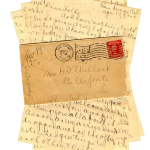 Remember the good ol’ days when people sent mail? A time when you could look forward to things being in your mailbox besides bills? Well, we’d like to bring those days back. Bill doesn’t always have time to answer emails from the wonderful people who write in. It usually doesn’t take very long to compose an email, but it DOES take a little dedication to write a letter, go buy yourself a stamp and mail that letter out at the Post Office. Therefore, if you send in a letter to Bill, he will try his best to answer anyone who writes in (and provides a return address).
Remember the good ol’ days when people sent mail? A time when you could look forward to things being in your mailbox besides bills? Well, we’d like to bring those days back. Bill doesn’t always have time to answer emails from the wonderful people who write in. It usually doesn’t take very long to compose an email, but it DOES take a little dedication to write a letter, go buy yourself a stamp and mail that letter out at the Post Office. Therefore, if you send in a letter to Bill, he will try his best to answer anyone who writes in (and provides a return address).
Before we provide you with the address, please make sure to read the list below for some pointers on what to send and what NOT to send in to Bill. Please read it.
Some ground rules:
Do NOT send anything in the mail that you would like to get back. This includes books that you want autographed, prints, posters and cats. Bill already has two too many cats.
Do NOT send food in the mail… things rarely turn up in the mail exactly how they were when they were sent out. Cookies and other foods are among the many things that you don’t want to eat to discover whether they’re still good or will give you food poisoning.
Do NOT send an invitation for something happening in a few weeks or a month or two… Bill’s schedule is really hectic and we often need a LOT more notice than that to make an appearance at something.
Please make sure your handwriting is legible if you’re actually writing your letter. I think it’s absolutely wonderful that you’re writing with like, a REAL pen and stuff (or crayons or whatever…), but it’ll make it really awkward and difficult to know what you’re trying to say if we can’t actually read it. If someone has ever told you that your writing looks like chicken scratch, then you should probably consider typing your letter.
Do NOT send scripts, portfolios or any type of professional work for Bill to look over. That’s a very big no-no. If anything like that turns up in the mail, it will immediately be thrown out. Seriously. Not only is this something that we definitely don’t have the time for, it’s also a big legal no-no. If you want to show your portfolio or something, bring it to a convention, but do NOT mail it to us.
Please try to keep your letters a reasonable length. Like 1-2 pages. Please.
With those guidelines in mind, the address is:
Bill Willingham
P.O. Box 158
Kasson, MN
55944
United States
Comic Vine: Bill Willingham Talks FABLES, Werewolves and Putting Characters in Tough Places
By Tony ‘G-Man’ Guerrero | Jan. 15, 2013
FABLES is one of those comics that has prestige. There are certain comics people know are really good, regardless if they’ve read it or not. FABLES takes the idea of fairy tale characters and places them in adult situations. By ‘adult situations,’ that doesn’t necessarily mean the naughty stuff. Having these characters hiding in the real world, trying to survive and fight their enemies has been a fascinating journey these past ten years. And that is the amazing thing, Bill Willingham has been writing these characters consistently for those ten years and (thankfully) there doesn’t appear to be an end in sight.
With the recent releases of FABLES: WEREWOLVES OF THE HEARTLAND, FAIREST Vol. 1 and the upcoming trade of Cubs in Toyland, we took the opportunity to talk to Bill about the world he’s created and characters he’s fleshed out.
[image error]
Comic Vine: When does WEREWOLVES OF THE HEARTLAND take place?
Bill Willingham: In series continuity, or in the FABLES timeline, it takes place just as Fabletown had lost their big battle with Mr. Dark. They were in the position of having to abandon the Farm. They hightailed it out and just as they were doing that, King Cole sends Bigby Wolf on a mission. He says, “Look, we’re down to our last refuge. We don’t want to have this and no other possibilities. So go find us another place to possibly rebuild Fabletown or just to hide out.”
During this time, Bigby wonders the land looking for another place to possibly build another Fabletown in America that is remote enough to survive. The original founding of Fabletown was back when New York was still New Amsterdam and it was still just a single settlement huddled on the southern tip of Manhattan Island. So they went up to the Upper West Side and said “This is remote enough. We’ll be left alone for centuries here.” Of course people spread out much faster than you expect. History rushes along much quicker than you hope for and they found themselves surrounded by New York City in almost no time at all.
The original idea was, let’s be remote and aloof from the rest of the world. They’re revitalizing that idea. Bigby goes to the heartland, to the American midwest because…well, it’s remote in many key places. The small towns of the midwest are dying because people are flocking to the cities and the coasts. The agrarian America is replaced by industrial America and now, electronic age America. The midwest is getting abandoned to a great extent. I think if we did replace Fabletown somewhere, it would be in one of these places where you can now go and buy the entire town just because it’s dying. You could pick up the entire place all at once, which is one of my ambitions by the way. I would love to just buy a town someday.
[image error]
Bigby’s wandering the heartland looking for places when he comes across Story City, Iowa, which is a real place, and it is not dying but for reasons that can only be explained by reading the book, seems to be inhabited entirely by werewolves. Which is where we get everything promised by the title, Werewolves of the Heartland. Bigby has to figure out why they’re there and how they came to be. It turns out to, without trying to spoil too much, have something to do with his past.
CV: Why did you choose a story with a specific time frame as a separate graphic novel?
BW: The time frame is just here’s where I can do it. Here’s a place in the longterm plans we had for FABLES, here’s the time in which I could get Bigby off by himself at this a moment. We have such specific plans for him so those times are rare. It was just the best time to do it. We wanted to do Bigby solo adventure for some time. It was just a matter of finding the place. One of the disadvantages of planning FABLES so far in advanced is that you do have to look for those niches of time and place in which to take a character off if you want that character to have his own adventure.
CV: With an original graphic novels, do you write it differently knowing it will be read in its entirety rather than spread across issues?
BW: I’m sure I do. I try to make sure each issue justifies itself because this is a serial medium. The readership is not too often put in a place of “Yeah, nothing happened in this issue but it sets up things for later on, so just bear with us.” That said, I don’t think that’s entirely an illegitimate thing to do if everything is all the height of payoff and resolution in every issue, then you don’t have the careful building of tension that really make the dramatic moments pay off. You have to have your highs and lows or you have to have times when it doesn’t look like much is happening but then when the big payoff occurs, you look back and say, “Oh, so all of that was important.” We try to balance that. I know the collection will be around much longer than the individual issues, the one that’s going to have to stand the tests of time, so probably my goal is more geared towards that. Ultimately though, with any story, the proof of it is, do they feel they got their money’s worth and not feel cheated at the end of however many pages you give them?
CV: Do you have thoughts of other original graphic novels focusing on other FABLES characters?
BW: Constantly! Much more than we could ever get to. Which is part of the reason of starting FAIREST. Since we can’t get to all the things that can be done with these characters, why not invite some other teams of writers and artists in to try their hand at some of it.
[image error]
CV: What’s your full roll in FAIREST? How much control do you have in characters used and direction of the stories?
BW: I suppose a lot of control. We’ve never gotten to the point where a writer wants to do something with a character that I don’t want and DC says, “You know what? To Hell with you Willingham, we’re gonna them do it anyway.”
The process of who does write a story for FAIREST starts with them kind of pitching the idea to me. I’m the first level of filter. That said, I’m trying not to rule this with an iron hand. It’s more a case where people are trying certain stories and I get to pick the best, most compelling one amongst several possibilities. And that’s a nice way to do it. Because inevitably, the deciding factor is which one of these do I most want to read as a reader and enjoy? The problem is, on one hand I want to control everything to make sure they don’t go too far off the rails in what is essentially my sandbox. On the other hand, I want to remain ignorant as to what’s coming up so I can see them as any other reader does to be surprised and fascinated by them. It’s kind of an ongoing conflict between those two extremes.
CV: With the first trade of FAIREST plus past series such as the CINDERELLA ones, what’s it like seeing stories from your world being written by others?
BW: It’s nice. The whole reason I write FABLES is this is the kind of story I enjoy. Any opportunity to see other people writing stories in this great big sandbox where I get to approach them as a fan and as a reader, I’m all for it.
The prose novel world has been revisiting fairy tale literature for some time so I get a good deal of that. I get to enjoy things like Once Upon a Time on TV that’s not FABLES. They’re taking these same characters in different ways. I get to say, “Ooh, I wish I would have thought of that” or “Ooh, I wouldn’t have done that.”
[image error]
CV: You recently did an eight part story in FABLES (“Cubs in Toyland”), do you approach the writing differently knowing you have more room to tell the story rather than try to fit it into 2 or 3 issues?
BW: Absolutely. There are some constraints. When we were doing The Good Prince, I think that was like a ten-parter, there were those moments when Shelly and others at DC/Vertigo asked “How much longer is this going to go on?” They did give me the room and the leeway. There were also some readers who were wondering when this was going to get wrapped up. I think those concerns are something that, in the individual issues, are a concern. But when they’re collected into a big collection, like the one that’s about to come out, it’s not really that important.
The story takes as long as it’s going to take. There’s very few times when someone’s in the middle of a huge novel that they’re thoroughly enjoying, and I’m being very arrogant here by the assumption that people are enjoying FABLES, but in the middle of a novel, people don’t say, “This is great. I’m having a great time. I just wish there weren’t so many pages left because I want it to be over soon.” If they’re anything like me, they get towards the end of a novel and they get sort of this regret over running out of pages. You just want it to go on.
That said, I take as a general rule, as much time as I want with a story. Cubs in Toyland being the most recent example of possibly doing it an issue or two longer than some folks would have liked. But it was those two issues that I needed. Even with these sprawling epics, near the end of them, I wish I had more room. There is that battle between getting to the point and having the room and the luxury in which to do it.
[image error]
CV: Your next arc is focusing on Snow White. She’s always been an incredible character under your guidance, what is it about her that sets her apart from the other Fables?
BW: Snow White was the very first character to be introduced in FABLES. Granted there was that one-page interaction between Jack and Bigby but it was Snow White that had the first sustained scene that we see okay, this is what she’s all about. This is the way she’s definitely not the Snow White you last heard of from the fairy tales. Because of that, I thinks she’s rightfully earned her place in the forefront of the Fables story outline.
But Snow White has never really had her story arc. She’s been an important part in many story arcs but this one is hers. The whole purpose of the arc is to really see what she’s made of. In most dramas you find out what people are made of by putting them a tough place. And Snow White is in perhaps in the toughest place she’s ever been in which is she has two missing children, which is a carry over from the ‘Cubs in Toyland’ story arc.
On top of that, her husband, Bigby, is away looking for said missing children. So she does not have him to rely on. It’s very easy, I would think, to be a tough piece of business like Snow White is when at the snap of your fingers you have the greatest of all monsters at your beck and call to back up your plate. One of the things we wanted to do was get rid of him right away. There’s no better way to do that than doing what a husband and father should do is if your kids are lost, one of you should stay home in case they show up and the other should go out looking for them. She’s on her own.
In addition to the missing children, some hardships come along, some challenging things and she does not have the opportunity now just to turn to the monster she’s married to. We’re going to see what she’s made of in an emotional, tactical and a physical sense.
CV: How many issues will this arc be?
BW: Five. It’s going to be pretty quick and deadly.
[image error]
FABLES #125
CV: You’re about to hit issue 125 and have been working on the series for ten years now, what is it about these characters that has kept you working on the series?
BW: One thing is it’s a sprawling cast. You don’t have to stay interested in any one character. So much of FABLES is a matter of taking one character aside and saying, let’s see what we can do with him. The “him” could be like in The Good Prince story arc, a character that was intended to be a one-joke in the background mopping the floor. We can say, well, what could be made of him once we put the pressure on him?
Fairy tales have an endless supply. Apparently we’re re-discovering new ones. There’s been this cache of a hundred or so fairy tales re-discovered. We’re not going to run out of potential characters. The rest of it is people continue to be interested. You fall in love and stay married to the same person for years at a time because that person continues to be a joy and delight to be around for a long period of time. I just think it’s the nature of you like exploring new characters but you also like being with old friends with whom you’re familiar. FABLES is in a position to capitalize on both of those.
CV: I hate to ask this but in the last ten years, did you ever think of taking a break from FABLES?
BW: Apparently the official view from Vertigo is ‘no.’ The other answer is, of course. But even though you and the readers get FABLES once a month every month for ten years, it’s not really done on a regular basis. I do a lot of things, a lot of different stories. I take breaks from FABLES all the time. The way that works is, like with the Snow White story arc, for example, I’ll do a bunch of issues of those all at once over a week or a few days. I’ll get ahead for a few issues and then take a break or extended break, which I did in this case, to go to Italy and finish a novel. There’s nothing like going somewhere and writing a novel, staying away from FABLES for more than a month and then come back fully refreshed. I said, “Whoa, I miss these characters and stories and I want to get back into it.” So it remains fresh in many ways because I’m able to structure the writing and take breaks from time to time.
CV: That’s great to hear. We’re absolutely looking forward to the next arc.
BW: Well thank you. Thank you very much. We are too. With any arc, I think we earn our readers back every time. We don’t get to rely on them always being there and I hope that they’ll find the Snow White story arc to be exciting and frustrating and compelling.
FABLES: WEREWOLVES OF THE HEARTLAND, FAIREST: WIDE AWAKE are on sale now. FABLES VOL 18: CUBS IN TOYLAND is on sale January 16 and FABLES #125 is on sale January 23.
Source: Comic Vine
January 3, 2013
Interview and Podcast Availability
 Bill is currently available to do interviews and podcasts to talk about Fables: Cubs in Toyland (Fables #114-121), which will be out on January 22, 2013 and Fabletown and Beyond.
Bill is currently available to do interviews and podcasts to talk about Fables: Cubs in Toyland (Fables #114-121), which will be out on January 22, 2013 and Fabletown and Beyond.
Fabletown and Beyond will be a convention entirely designed to discuss, promote and celebrate comic books that fall within the Mythic Fiction realm. You can find out more about it on the Official Web Site.
Send in your requests to stephanie@billwillingham.com. There is a limited number of spaces for interviews and podcast requests, so get them in ASAP and we’ll try to fit you into our schedule. If we aren’t familiar with your site, we may ask you for additional information. Interviews for the web or magazines must be conducted via phone or Skype.
Please include the following subject in your email: “Interview /Podcast Request” (put whichever applies to you).
December 20, 2012
Bill Willingham Speaks: The Fables and the Facts
By Mark Syp (Subculture for the Cultured)
For over a decade, Bill Willingham has been entertaining readers with his award-winning Vertigo series “Fables,” which presents his unique take on the fairy tales and folklore we only think we know.
Now, as a special treat to “Fables” fans and an invitation to newcomers, Bill has created the oversized graphic novel “Werewolves of the Heartland,” which provides a look at a brand new corner of the “Fables” universe and presents previously unrevealed backstory about the enigmatic and popular Bigby Wolf.
Mark Syp: Tell us a little bit about Werewolves of the Heartland.
Bill Willingham: Well, between the title and the front cover illustration, you can get a good idea what the book is about. You know the old saw “you can’t judge a book by its cover?” This time you can.
Bigby Wolf goes to the American heartland, encounters werewolves and hilarity ensues. He’s on a quest to find a new possible location for Fabletown and runs across a small town called Story City. Bigby discovers that this seemingly pleasant and picturesque town is occupied entirely by werewolves. They don’t like having Bigby around and his merely showing up starts causing all kinds of crises. They also seem to know a lot about him and he has never heard anything about them. The mystery unfolds from there.
It’s a done-in-one story featuring art from Craig Hamilton and Jim Fern. Even if you’ve never read Fables before you should be able to navigate the story with no problem at all.
MS: Tell us a little bit about Story City.
BW: There’s actually a real Story City outside of Ames, Iowa. Once I discovered a Story City exists, I couldn’t not set a Fables story there. Since we had already started planning what was to become Werewolves of the Heartland and since Story City is in fact smack dab in America’s heartland, a marriage of convenience was born.
MS: I know every couple of years you like to do something special for the fans of Fables and create a bigger project. What led you to doing an original graphic novel?
BW: The main motivation was to do it. 1001 Nights of Snowfall was a graphic novel of similar size, but it was all short stories. Peter and Max was a prose story. It was illustrated but not a graphic novel, where the illustrations are half of the process. What was left in that equation was to go back to story and art together, but in long form.
Don’t hold me to this, but I’m almost sure this is the longest done-in-one story I’ve done. Some of the Fables story arcs were longer, but they were serialized as single issues and then collected into trades. One of the things I try to do with these specials is do something I haven’t done before and setting out to tell a story from beginning to end in one huge chunk was a new experience for me.
MS: 1001 Nights was an anthology and Peter and Max featured characters who, while based on fairy tales, were original to the world of Fables. Why did you decide to focus on Bigby, who is arguably one of the main characters of the series?
BW: While Bigby is one of the main characters of Fables, and certainly the most popular male character, in 100-plus issues he’s never really had a story all his own. That alone seemed to argue for him having his own big, sprawling story.
Bigby’s name is a play on words, since he’s the Big Bad Wolf of legend, but reformed. In Fables, we’ve only really seen him since he’s been reformed. We’ve alluded to, hinted at and teased about his giant monstrous past, but we’ve never really shown it. The question kept coming up, “Is the monster inside him tamed, and what would happen if he cut loose?” This story answers that question.
MS: This story does reveal a lot of Bigby’s back-story. Is that a story you’ve kind of had in your pocket and been wanting to tell for awhile?
BW: As a writer telling new stories with older material, which is essentially what Fables is, one of the jobs you have is trying to subvert what’s gone before. One of the rules I set for myself with Fables is that all of the old fairy tales happened pretty much just as they’re well-known, but here’s what’s happened since then. We start off with the stories back then, but have the characters go through amazing transformations by the time you see them again. With every character, I sort of work out the story arc of what happened.
Since these characters are essentially immortal, you can tell stories all over the historical map. We did a two-part World War II story with Bigby in Fables. The story was about him going behind enemy lines to thwart a Nazi scheme and succeeding. Even while writing it, I found myself subverting the story and looking for loopholes and ways to make it not turn out quite so clean and pristine an ending as they thought they had. Werewolves of the Heartland is the result of that nagging at me over the years, leading me to undo some of what was done in that story and have some fun with it. And for new readers we fold that back-story into the new story, so it stands on its own.
MS: Although, I will say that if you are a reader of Fables it really does compliment the main title. For instance, Story is in many ways Fabletown gone wrong.
BW: Well, it parallels Fabletown, but with werewolves instead of fables. And the politics of it are, here’s Fabletown if we were a little more Draconian, a little more toe the line or else, and the factions that would form.
MS: The original two-parter this story is based on drew not only on fairy tales, but also a number of urban legends about World War II and, since Frankenstein’s monster was in it, a lot of the Hollywood interpretation of Frankenstein. What constitutes a legitimate source you can draw from?
BW: The two real governing rules are, “Is the story or character in the public domain?” and with that said, “Do I want to use it?” That’s really it. I like to give myself a lot of leeway in where my interests go.
The Frankenstein creature is certainly in the public domain. In the original book, the creature came out looking human, almost handsome, and the monstrous nature slowly revealed itself. In the movie, they jump right to the climax and he’s a monster from the get go. The Hollywood version is similar to what we do in Fables, which is take the original story and twist it and subvert it to make it our own. Since the story in Fables took place during World War II and the original Frankenstein story took place long before that, there’s plenty of time for the creature to have started off looking human and then degraded into his monstrous form.
MS: It also dovetails with urban legends about Nazi scientists and their experimentation. And, of course, some of that unfortunately wasn’t urban legend. You look at an urban legend like The Boys From Brazil and say, “maybe they weren’t cloning Hitler, maybe they were resurrecting Frankenstein.”
BW: Yeah, it’s an extrapolation of the some of the stuff they were really trying. It’s a weird crazy world out there, so let’s have some fun and poke some holes in it.
MS: Let’s go back to the notion of not ignoring a particular character’s back story. When I tell people about Fables, one thing they always seem to find particularly delightful is the fact that you saw that Prince Charming was the name given to the love interest in the tales of Snow White, Sleeping Beauty and Cinderella and decided it was the same guy and he was just a womanizer.
BW: You can extrapolate some fun things from the fairy tales if you take them at their word. One of the decisions I made early on was that we could combine similar characters into a single character, if we could do it without denying the clear intent of the original storyteller and instead add to it.
MS: While you’re indeed true to the original tales, you’re also not afraid to shake things up. I remember talking to you before the “War and Pieces” storyline and you said it won’t be a few issues of fighting and then a return to the status quo. The war would have consequences and there would be a new status quo.
BW: One of the problems the big comic companies are faced with is that they have stockholders, which makes each character a valuable company asset. You can’t just throw away a valuable company asset willy-nilly. You have to be careful not to upset the status quo too much.
Compare that to Fables, where these versions of the characters are mine and mine alone. That leaves me to tell a lot of stories that others can’t. If, for the good of a great story, a beloved and valuable company asset has to go, they’re going to go.
MS: In recent arcs you’ve been working with Bigby Wolf and Snow White’s children, whom I assume to be original characters. Is that correct?
BW: There weren’t fairy tale characters that were the children of Snow White and the Big Bad Wolf, since those two characters never got together, that I know of. There were tales called Beast Romances, where a beautiful woman ends up married to a creature of the forest, with the best known being The Frog Prince. So, the precedent was set for their romance.
The kids are the same way. They’re all characters I created from the ground up. But there are seven of them, since that’s an important number in fairy tales. Bigby is the seventh son of his parents, who is supposed to have magical properties, which Bigby did. The fact he would have seven children seemed to be a no-brainer. That’s a recurring motif in folklore. So, there is some aspect of the children that was drawn from folklore, just not the specific characters.
MS: Of course, there’s the prophecy surrounding the children. Have you figured out what it all means?
BW: Oh, yes. That was fun to write. I wanted to move the story of the children along and force myself to make it dangerous and interesting. Why expect readers to continue reading if there’s not some big, heroic, adventurous and dangerous stuff coming up? So, to lock myself in, I wrote the prophecy and then started figuring out what it might mean.
We’ve seen a little bit of it already. We’ve seen Winter become a King. That’s not a mistake; she becomes a King, not a Queen. We’ve seen the second big element of the prophecy come about. I don’t want to spoil it, since it just happened. We’re moving on to the others.
MS: So you’re confirming those events are actually the prophecy being fulfilled and not clever misdirection?
BW: They are. I love clever misdirection and I should do it more often, but in this case you can trust it was pretty much as it was prophesied to be.
MS: How far out do you have Fables planned? I know there’s no set end point. The last time I spoke to you, you said, and I quote, “If I have my way I would work on Fables until the day I die.”
[Both laugh]
BW: That would be a good way to go. Finish up the very last issue, tie up all of the dangling plot threads and then keel over nicely and gently. That worked for President Grant when he was finishing up his memoirs. I want that same deal, to complete Fables before anything happens to me. Then, like the tricksters of folklore, I’ll just keep writing Fables forever and keep living on.
[Both laugh]
MS: So how far ahead does the mortal you have the story planned out?
BW: In a dialed-in, specific way, with plotlines and some dialogue written down, we have it plotted out for another two years at any given time. In a general way, we have two to three years beyond that.
MS: So what can you tease without getting in trouble?
BW: We just finished up the story arc set in the past that shows just how Bigby became fated to be whom he is. It demonstrated how fate works in the Fables universe. Next, we have one issue tying up the Bufkin storyline.
After that, we begin the Snow White story arc. As you know, if you’re a Fables character it’s a pretty unlucky thing to have a story arc named after you, because we have to put you through the wringer. We really see what you’re made of and put all sorts of dire challenges in your way.
Snow White’s not having a good time right now. Several of her kids are lost and she doesn’t know if she’ll see them again. On top of that, we’re going to pile on some other challenges. We’re really seeing Snow at a moment when all kinds of crap is coming down on her at once and we’re going to see what she’s made of. We did a similar thing to Rose Red and Rose took to her bed for several months. Snow White is not going to react in the same way, because it would get boring if every time we focused on a character they spent several months in bed (laughs). I’m not going to tell you what we’re going to do, but Snow White will definitely come out of this arc a little bit different than she entered into it.
Following the Snow White story we’ll have a one or two issue interlude. The next big story arc after that has the working title “New Camelot.” It’s about the restoration of the Camelot ideal. I wouldn’t be surprised if there was actually a new Round Table. I personally wouldn’t be surprised because I know what we’re doing and we’re going to introduce a new Round Table.
[Both laugh]
MS: You work very closely with Mark Buckingham on Fables, since he’s the permanent artist. What was it like working with other artists for Werewolves of the Heartland?
BW: It’s always nice working with different artists. There are so many nice comic artists out there and I’d love to work with each and every one of them. One of the joys of Fables is that it’s popular enough that all kinds of incredibly accomplished artists are interested in visiting the Fables landscape from time to time and doing something.
That said, it’s always preferable to work with Mark Buckingham. He is artistically the heart and soul of Fables. If working with other artists is going out and having adventures, Mark is like coming home again. And it’s always nice to come home again.
I told Mark that if I could adopt him I would (laughs), since he is absolutely not allowed to leave Fables. In that scenario where I die peacefully right after writing the end of Fables, he’s not allowed to die until about a month later so that he can draw the last one.
[Both laugh]
MS: While we’re talking about collaborations, you recently debuted the spin-off series Fairest. After you write the first story arc, each subsequent one will be by a different writer.
BW: Part of that was to have the balance we didn’t get with Fables. With Fables we’ve had the opportunity to work with all of these great artists, but we were leaving off half of the creative force of comics. So, part of the idea of Fairest was to work with all of these wonderful writers that are out there. Of course, we need artists for those stories too, so we get to have even more great artists play in the Fables sandbox.
The other origin of Fairest was Adam Hughes, who is our wonderful cover artist. A few years ago at a convention Adam asked me if he could be the cover artist on Fables. I told him we had just found a new cover artist, so the answer is no. However, if you’re serious, says I, I’ll create a new Fables series for you, which I did.
MS: Is it strange to have other writers working with your characters? In a way, you’ve been playing with the Brothers Grimm’s babies; they in turn were playing with folklore. Is it weird to see people doing, for lack of a better term, the Bill Willingham Snow White or the Bill Willingham Big Bad Wolf?
BW: Yeah, it is. We had a couple of Cinderella miniseries that helped spawn the idea of doing a book with arcs from different characters and creators. Chris Roberson came to me and said, “You should do this with Cinderella” and laid out some pretty wonderful story ideas. I said, “That’s great, but that’s not my idea, it’s yours. You should write it.” That’s how the Cinderella miniseries’ came about.
Fairest works the same way. We don’t contact the writers and say “Could you do a story with this character, this way.” Instead, they come to us and say, “If I could use this character, this is what I’d do.” The cleverest ideas are the ones that get chosen.
MS: The characters the creators choose to work on is a Rorschach test of sorts.
BW: Absolutely. That’s a great way of putting it. When you get together and say “you’re a great writer, you’re a great artist, that’s a great idea. Do it!” There’s really no better formula for success.
MS: In closing, I don’t want to give anything away about the ending, but is Werewolves of the Heartland going to meet up with Fables in any way?
BW: Let me give you an answer that doesn’t give away any of the secrets and surprises in the story. The story definitely takes place in the Fables universe and if by any chance any characters survive that story there’s a good chance we’ll see those characters pop up in some way.
“Werewolves of the Heartland” is in stores now and, as Bill pointed out after the interview, makes a great Christmas present. “Fables” and “Fairest” are available monthly from Vertigo.
Source: Subculture for the Cultured
December 18, 2012
Paul Cornell’s Twelve Blogs Of Christmas: Nine
This post is most explained by Paul Cornell below, but basically Bill decided to help out with Paul’s annual Twelve Blogs Of Christmas (specifically Nine) and we’re posting up the results of that here. You can check out the original post over on PaulCornell.com as well.
———————————————————————————————————————–
I should have mentioned The Newsroom in yesterday’s round up of television I liked this year. And as Adam Christopher pointed out, Person of Interest, with its predictive tech, is actually rather more telefantasy than Arrow is. In this spirit of correction, I should also add that Thomas’ soft toy scarecrow was actually made by Sarah Pink (@SarahPink1000 on Twitter). Thank you, Sarah.
Today’s guest blog is by the chap that suggested the theme in the first place. When I was rather desperately casting around on Twitter for a solution to my seasonal blog problem, Bill Willingham appeared, saying that he ‘wanted nine’. When I asked him what he meant, he told me I was going to get in twelve guest bloggers and have them write about ‘The Twelve Days of Christmas’, and he was going to do the ninth one. So I did, and it worked, and he has. I think perhaps he’s some kind of Fairy Godfather.
Fables, is, of course, the best comic in the world, and I’m privileged to have as friends both its creators. The following sums up, I think, why Bill continue’s to be one of comics’, and the genre in general’s great storytellers. He’s talking, in theory, about Nine Ladies Dancing! Take it away, Bill…
Nine Drabbles of Christmas
By Bill Willingham
‘See, here’s the thing. The ninth day of Christmas is the Nine Ladies Dancing one, except it isn’t, for a number of reasons.
Reason number one: I won’t dance. Don’t ask me. I have ever only danced a few times in my entire life, only when I have been so massively drunk that I’d lost my ability to refuse such carryings-on. On one such occasion I was escorted (very politely) from the dance floor, by DC Comics honcho, Paul Levitz, who carefully explained to me I was banned from the dance floor for being far too drunk and stepping all over the DC Comics President and Publisher at the time, Jeanette Khan. Other dancing times were undertaken with similar disastrous results.
Reason number two: tangentially related to reason number one, is that I’m not qualified to speak of nine ladies dancing, since in all of my dancing life, I haven’t reached that number of dancing partners. As near as I can reconstruct faulty memory, I can put the number no higher than five.
Reason number three (and this is the real one underpinning what we’re about to do here): Nine Ladies Dancing don’t have to be nine ladies dancing. The traditional “Twelve Days of Christmas” song has traditionally had many different items in each of the daily slots (with the exception of Five Golden Rings, which seems to always be five gold rings, no matter what the iteration), nine ladies dancing being only the current vogue in the number nine slot. In the past it has been nine lords a leaping, nine drummers drumming, nine ships a sailing, nine pipers playing, nine bears a beating, and so many others, including my favorite, nine badgers baiting.
Since the real tradition is that just about anything can be in any given slot, and since we’ve established I don’t actually know nine ladies dancing, and I won’t dance myself, I’m going to uphold the tradition by doing my own thing in the nine slot. The only thing I can possibly be trusted to do nine of these days is tell nine stories.
Herewith…
On the ninth day of Christmas, my true love gave to me, nine drabbles a drabbling.
Here then is my gift to you, my true love: nine Christmas drabbles, for your reading pleasure. The rules are simple: to qualify as a true drabble, the story must be no more and no less than exactly one hundred words. Titles don’t count against the total, and hyphenated words count as single words.
Got it?
Then let us begin.’
Flying High
He was Spritzer, one of the original team, when they were nine, rather than the more famous eight, but few remember him, since considerable effort was made to erase any mention of him from official records and the larger legend beyond.
“Not everyone can handle the level of fame this job brings,” the fat man said.
“Nonsense, I’m fine.”
“Not even close. You’re high as a kite.”
“Flying is our thing.”
“And now this,” Santa said. He set a videotape in front of the deer. “Porn? Seriously?”
“My chance to break into movies.”
“Disgusting!” And with that, Spritzer was out.
Black Christmas
This was Bindelbob’s first year working the black gang, the elite team of elves responsible for filling the coal hopper on Santa’s sleigh.
“What are all these deductions from my paycheck?” he asked Senior Elf Crumplehat. “Reform for Troubled Teens? Solutions Dot Net? The Rehab and Reentry Project?”
“Some of the charities we underwrite,” Crumplehat said.
“But how can deductions be mandatory here? Back in Toy Production I was free to pick my own causes.”
“In this case it’s a legitimate work expense,” Crumplehat said. “When we support what turns the naughty into nice, we have less coal to load.”
Concerning Our New Rules of Conduct for This Year’s Christmas Party, After the Unfortunate Events That Occurred as a Result of Incidents (Alleged) Which May or May Not Have Taken Place at Last Year’s Office Christmas Party…
She had a fancy frock and dangerous shoes,
Strong enough to kill the Christmas blues,
At the office party up on floor thirteen.
She arrived in soft resplendence,
Displaying but a small hint of dependence,
On the pint or three she’d had in the canteen.
“You’re Betty from Receivables, isn’t that right?”
Said the exec named Mr. White.
“Right as rain,” said Betty with her fortified smile.
“And I know you. You’re the man,
“Who bedded my best friend Anne,
“Then denied it at the wrongful termination trial.”
That’s when Betty pulled the gun.
And now, alas, our story’s done.
A Small Part of the Legend
It was a humble thing, the last candle off the line, when the paraffin was running low, not worth restocking so late on Christmas Eve, since all would be shut down the next day. In a production of four-hour candles, it was good for ninety minutes at best.
“Can’t honestly sell it,” the candle-maker said. “We’ll keep it.”
They placed it in the window, where it spent its flame quickly, shedding small light, not accomplishing much.
Except…
Before it expired, its tiny flicker attracted one ragged, weary traveler to their door.
“A shelter against the night?” asked the king disguised.
Behind the Scenes
Santa was weary (hardly news there), but at least he was nearly done. Sixty thousand more deliveries and he could rewind The Watch, starting time again on its normal pace.
The Great Powers That Oversee didn’t mind him fiddling with the catholic timeflow, since his mission was benign. He brought free stuff. Everyone likes free stuff.
But those Powers didn’t realize Santa was just a front. A gaudy, colorful distraction. Elder things, dark, remote and resolute, took action whenever time halted. Soon they’d make their move into our bright and lovely world, pre-corrupted by all the free stuff, magically delivered.
Marching to the Beat
The son of God and Lord of Hosts seemed a restless sort, constantly traveling from town to town, never staying in one place for long.
“It’s his mission,” one of his followers explained. “The life of an itinerant preacher.”
And that much was true, but he was also a man searching. One day he’d find him, that shepherd boy, grown up now. The drummer who wouldn’t stop, beating, beating, beating, while he lay helpless in his cradle, already terribly aware, but unable to act.
“Now that I’m in my power, I can finally thank him properly for his Christmas gift.”
Under the Tree
And finally all the presents were opened, save one.
“I don’t remember wrapping that one,” Father said.
“It’s not addressed to any of us,” Mother said. “Wait, here’s a tag on the back.”
“What does it say?” Bobby said, hoping it would be another gift for him.
“It says, ‘The last gift for the last Christmas,’” Mother read.
“Don’t open it!” Father nearly screamed. “That’s some end of the world type language.”
“I’m not a moron,” Mother said. “We’ll put it away and never touch it.”
And that’s how the Andersons became the guardians of all mankind. Except Bobby, who really, really wanted to know.
A Man in Full
He received such delightful things. A Scotty Cameron golf putter. An Atomic Aquatic Cobalt nitrox-integrated dive computer with digital compass. Handmade Italian leather driving gloves. A case of Shafer Vineyards Relentless 2008.
Everything was perfect, exactly what He wanted, because it was on his list, which is how efficient Christmas giving should be done.
His gifts to others weren’t so carefully targeted. They were also on a list of what he wanted – what he knew they should want, if only they had the education and character to realize it.
“Master your life,” he oft opined.
Elsewhere flames were efficiently stoked.
True
She’d no money to buy a tree, so she drew one on her apartment wall with colored chalk. Over the next days she sketched packages underneath, bright and bedecked.
On Christmas morning no miracle had occurred. The tree and gifts were still lines and pigments on a wall. No one called, because her phone had been turned off months ago for non-payment. No one arrived. No spontaneous gathering of old friends and loves bringing good food and spirits, despite hopeful daydreams that they might.
Then again…
The way the morning sunlight fell across the snow outside.
“Blessings enough,” she said.

Among a long list of comics stories and series, Bill Willingham is the creator and writer of the long running Vertigo comic book series Fables. His novels include Peter and Max, Down the Mysterly River, and Tom O’ Harrow (forthcoming). You can find him online here or via Twitter @billwillingham. He’s a proponent of the Mythic Fiction movement in comic books, which includes hosting a convention early next year celebrating those sorts of books. You can learn more about that here.
Thank you so much, Bill. We’ll continue tomorrow with comedian Joseph Scrimshaw talking about… Ten Lords a Leaping! (Hmm, is that right?) Until then, Cheerio!
Source: PaulCornell.com

